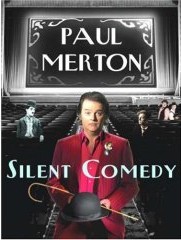
'Silent Comedy' By Paul Merton , London: Random House, 2007
ISBN 978 1 9052 1170 8 321pp. (hardcover) £25.00
As we move briskly into the 21st Century it is perhaps inevitable, and
also lamentable, that some past history is forgotten. Film suffers as
much as any other art form in this regard, for each new cinematic
release adds another few lines to review books and occupies another
space on the DVD rack in high street shops. Thus it is that filmmakers
and films themselves, once household names who became slightly
marginalised, find themselves now omitted from books, the films barely
available unless one knows where to look online. It is the task of
present generations not only to find their own niche but also to keep
alive the spirit of those who laid the foundations for what followed.
After all, without any idea of context and who originally did what,
youngsters of today might believe the songwriting ability of Westlife
to be second to none: Seasons In The Sun, Uptown Girl and Miss
You Nights to name but three.
As the author of Silent Comedy, Paul Merton is a prime example
of a modern popular entertainer who openly acknowledges his debt to the
great heritage of silent comedy. His book, coming hard on the heels of
his excellent BBC television series Paul Merton’s Silent Clowns,
does exactly that. This book, though, is not merely a re-working of
that series although it does, by necessity, cover the four leading
comedians profiled for the BBC (Buster Keaton, Charlie Chaplin, Laurel
& Hardy and Harold Lloyd). Instead, the book paints a vivid picture
of the development of film comedy in the pioneering days before sound
by interweaving the careers of all the comedians concerned. It is also
refreshing that Paul Merton does not stop at the comedians that are
still familiar to 21st Century Britain but also highlights those who
were influential but have since been overlooked, such as Larry Semon
and Harry Langdon.
A key strength of Silent Comedy is its straightforward
approach- a clear set of ten main chapters dealing with key moments
separated by stylish pages deliberately resembling film intertitles
placed opposite an appropriate full colour poster or lobby card. This
simple- but highly effective- organisation enables the book to be
instantly appealing and accessible, a marked change from some books
about silent cinema which are aimed squarely at the academic who
already possesses some detailed knowledge. Paul Merton makes no such
assumptions about his reader, and the result is a delightful melange of
thoughtful narrative insight, personal enthusiasms (such as the
double-page spread on the 1929 Laurel and Hardy film Big Business)
and high quality images. The double-page spreads themselves are worthy
of special mention, for their full and varied colour contrasts the
white background of the majority of the book yet compliments the rest
of Silent Comedy most delightfully as they provide a focus on a
specific moment of silent film history (whether it be one particular
comedian, a key film or simply the context of silent film production).
The rest of the book takes a largely chronological approach towards
charting the development of silent comedy but does tell the story
through its key players. Such a story is an ambitious task, but Paul
Merton approaches it and accomplishes it with an equal degree of
relish. Unlike many more picture-dominated books about silent cinema,
Merton’s use of rare behind-the-scenes (or ‘candid’) stills to
supplement frames from the films is a huge plus, for it makes his book
that bit different from other accounts of silent screen comedy.
Although the book is titled ‘Silent Cinema’, Chapter Ten provides a
fitting epilogue with its focus on the coming of film sound. Merton is
able to use this as a springboard to unravel the main comedians
(Keaton, Chaplin, Laurel & Hardy and Lloyd) and provide a brief
resume of their final years. The book is completed by a thorough
reference section which makes it very easy to use and provides a
satisfying conclusion. All in all, Silent Comedy is a superb
piece of work- Merton is able to use his insight into how comedy works
to explain why these comedians were so great and still deserve to be
remembered (and even celebrated) today. One of the main problems with a
book such as this could be either the absence of the author’s
personality or, alternatively, too much of it. Paul Merton manages to
tread this fine line to perfection, using anecdotes to personalise and
bring alive the whole experience of enjoying silent films without it
becoming a book about his cinema-going preferences. In Silent Comedy
Paul Merton acts as ambassador- not only for those comedians he
spotlights and the famous films he enthuses about, but also for those
who have been forgotten by time. Silent Comedy should hopefully
serve to attract many new fans to the joys of silent cinema, but there
is plenty within its smart covers to appeal to those who are already
converts of pre-talkie comedy.
'Silent Comedy' is published by Random House.
Random House website
Back
Home

